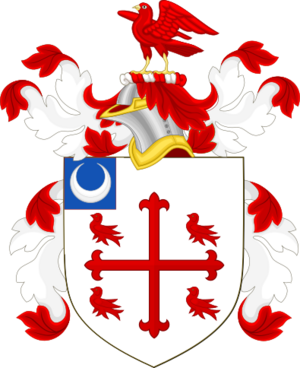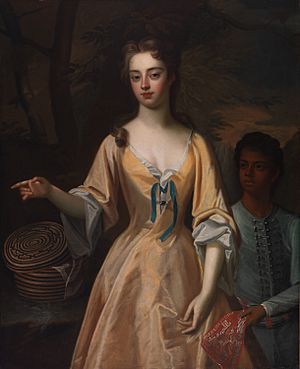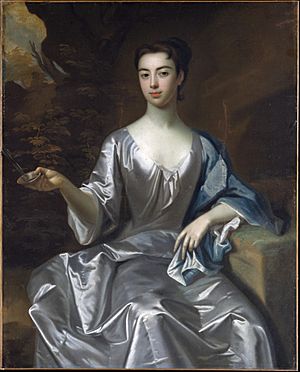William Byrd II facts for kids
Quick facts for kids
William Byrd II
|
|
|---|---|
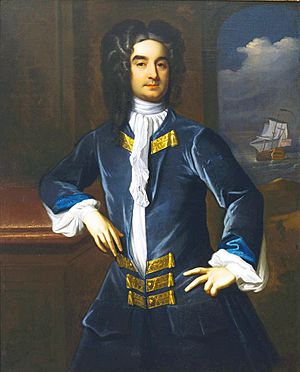 |
|
| Born | March 28, 1674 |
| Died | August 26, 1744 (aged 70) Charles City County, Virginia, British America
|
| Resting place | Westover Plantation |
| Education | Felsted School (classical) Middle Temple (law) |
| Occupation | Planter, statesman, and author |
| Known for | Founding Richmond, Virginia |
| Title | Colonel |
| Spouse(s) |
|
| Children | 7, including William Byrd III |
| Parent(s) |
|
William Byrd II (born March 28, 1674 – died August 26, 1744) was an important person in early American history. He was a planter, a lawyer, and a writer. He was born in Colonial Virginia and studied in London, England.
After his father passed away in 1705, William Byrd II returned to Virginia. He served on the Virginia Governor's Council for many years. He also worked as London's representative for the House of Burgesses. Byrd helped shape both British colonial life and the new American identity.
He led teams that surveyed the border between Virginia and North Carolina. He is also known for founding the city of Richmond, Virginia. Byrd owned many large farms and led local military groups. He also helped start iron mining businesses. He was a member of the Royal Society and supported early ways to prevent smallpox.
Byrd is famous for his detailed diaries and travel writings. Some of his writings are even used in American literature textbooks today.
Contents
Early Life and Education
William Byrd was born on March 28, 1674, in Henrico County, Virginia. He was the oldest child of Mary Horsmanden Filmer Byrd and William Byrd I. His father was a successful farmer, public official, and trader with Native Americans.
When William was two, his mother took him to England to visit family. In 1681, he started school at Felsted School in England. There, he learned languages like Hebrew, Italian, and French. His father wanted him to become a well-educated gentleman.
He also worked for two years in London and Rotterdam. He learned about the tobacco trade and how to do business. During this time, he also learned the social skills of a gentleman.
From 1692 to 1695, he studied law at Middle Temple. He became a lawyer in 1695. The next year, he joined the Royal Society. This was a group for important scientists and thinkers.
William Byrd spent most of his childhood in England. But because he was born in Virginia, he was not fully accepted as an Englishman. This made it hard for him to marry into a noble English family or become a politician there.
His Career and Public Service
William Byrd returned to Virginia in 1696 after being away for 15 years. Because of his good education and his father's influence, he was chosen for the House of Burgesses. However, he soon went back to London to practice law.
In 1698, he became the London agent for the Virginia Governor's Council. This job allowed him to represent Virginia's interests in England. He worked to protect his father's important government jobs.
In 1701, he took a 14-week trip around England with a young nobleman named Sir John Perceval. Byrd was 26 and knew a lot about England. He introduced Perceval to many important people. Byrd was interested in the businesses, art, books, and buildings they saw.
His father died in 1705, and Byrd returned to Virginia. He inherited most of his father's wealth. This made him one of the richest men in the colony. In 1709, he was appointed to the Virginia Governor's Council. He held this important position until he died.
Byrd traveled to England again in 1715. He wanted to discuss issues with the Lieutenant Governor, Alexander Spotswood. While he was there, his first wife, Lucy, joined him and sadly died of smallpox.
In 1718, Byrd was again appointed as a London agent. He returned to Virginia in 1720 and worked to improve his relationship with Governor Spotswood.
In 1721, he became a paid agent for the House of Burgesses and went back to England. He returned to Virginia in 1726. In 1728, he was chosen to survey the border between Virginia and North Carolina.
William Byrd II is credited with establishing the cities of Petersburg and Richmond, Virginia. He founded Richmond on his own land in 1733. By 1743, he was the most senior member of the Virginia Governor's Council.
Marriages and Family Life
Lucy Parke Byrd
William Byrd married Lucy Parke on May 4, 1706. Lucy was the daughter of Daniel Parke, who was a governor of the Leeward Islands. Lucy lived near Colonial Williamsburg with her mother and sister.
Lucy's family had some financial difficulties. Byrd was promised money when he married Lucy, but he only received it after her father's death. He also took on some of her family's debts.
William and Lucy Byrd sometimes had disagreements. Byrd's diary shows that he often left his family for long periods. Their children were Evelyn Byrd and Wilhelmina Byrd.
Lucy followed Byrd to London and sadly died of smallpox in 1716. Byrd was very sad and blamed himself for her death. He wrote about her pain and how she bravely faced the news of her illness.
Maria Taylor Byrd
Byrd married Maria Taylor on May 9, 1724. She was 25, and Byrd was 50. Maria came from a wealthy family in Kensington, England.
Maria was different from Lucy. She was well-mannered and kept the household running smoothly. Some historians thought she was a very obedient wife. However, others suggest she was stronger than her husband's diary might show.
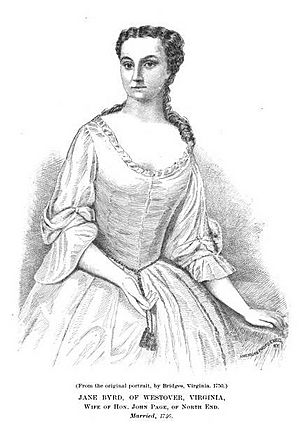
Their children were Anne Carter, Maria Taylor Carter, Colonel William Byrd III, and Jane Page.
Maria Taylor Byrd lived 37 years longer than William. She received money from his will as long as she stayed unmarried and lived at Westover. She also took control of their children's education.
Personal Diaries
William Byrd II kept a detailed diary from 1709 to 1712. It was written in a special code and first published in the 1940s. The diary mostly talks about his daily life. Many entries use the same phrases.
A typical entry might say:
[October] 6. I rose at 6 o'clock and said my prayers and ate milk for breakfast. Then I proceeded to Williamsburg, where I found all well. I went to the capitol where I sent for the wench to clean my room and when I came I kissed her and felt her, for which God forgive me ... About 10 o'clock I went to my lodgings. I had good health but wicked thoughts, God forgive me.
The diary also records how he managed the enslaved people on his plantation.
Literary Pursuits
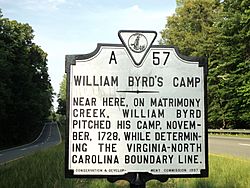
Besides being a planter and politician, William Byrd was a great lover of books and writing. He collected one of the largest libraries in colonial America. It had 3,500 books in many languages, including English, French, and Latin. His collection covered topics like history, science, and art.
Byrd was also a very active writer. He wrote essays, historical accounts, speeches, poems, and diaries. He also wrote letters to famous scientists and writers of his time.
Most of his early writings were not published until after his death in 1744. At first, critics did not think much of his work. But in the late 1900s, people started to appreciate his writings more.
The History of the Dividing Line is his most famous work. It is often included in textbooks about early American literature. This work, along with The Secret History, helps us understand the attitudes and ideas of his time.
Major Works by William Byrd II
Many of Byrd's works were published after he died. Here are some of his most important writings:
- A Discourse Concerning the Plague (1721)
- The Westover Manuscripts: This collection includes History of the Dividing Line Betwixt Virginia and North Carolina, A Journey to the Land of Eden, A.D. 1733, and A Progress to the Mines. These were written between 1728 and 1736 and first published in 1841.
- The Secret Diary of William Byrd of Westover, 1709–1712 (1941)
- Another Secret Diary of William Byrd of Westover, 1739–1741, with Letters & Literary Exercises, 1696 (1942)
- The London Diary, 1717–1728 and other Writings (1958)
- The Prose Works of William Byrd of Westover: Narratives of a Colonial Virginian (1966)
- The Commonplace Book of William Byrd II of Westover (2001)
Death
William Byrd II passed away on August 26, 1744. He was buried at Westover Plantation in Charles City County, Virginia.


